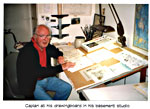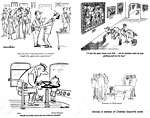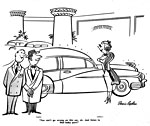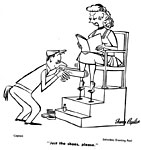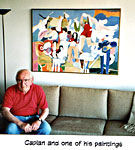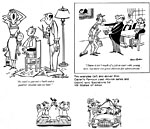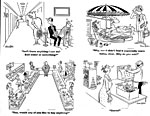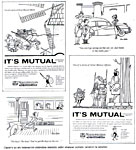|
Irwin Caplan, 1919-2007
Advertising Cartoonist
Irwin
“Cap” Caplan died on February 22 of complications related to Parkinson’s
disease. He was 87. In the 1950s, his single-panel cartoons were in all the
major magazines. I saw them everywhere. He was one of the cartooning heroes of
my youth although he surely didn’t know that until the summer of 1998, when,
working as advance man for a convention, I met him at his home in Seattle. The
result of that visit is the article that follows, originally published in Cartoonist PROfiles (No. 128, December
2000). ..............................
Irwin Caplan’s magazine cartooning style is as brisk and refreshing as a splash of cold water on the face. And it wakes you up, too. His bold lines have a sculpted look. They wax and wane, but the thick lines don’t suggest volume or weight as is usually the case with undulating linework. Instead, they often get thickest at their terminus, where they join another line to complete a shape. The final effect is a kind of chiseled angular flatness—clipped and crisp and clear, distinctive and arresting.
During the 1950s, Caplan’s heyday as
a magazine cartoonist, I was watching his work in Saturday Evening Post, Collier’s, Look, This Week, True, Esquire,
Argosy, and a host of other outlets that littered the periodical landscape
in those halcyon days. Watching and marveling.
“Your line is often fatter where it
ends than it is in the middle,” I said to Caplan when I talked with him in his
Seattle home in June 1998. “And that’s what made your style different: nobody
whose work I know does that.”
Caplan was a little amazed that I
would have studied his work in such intimate detail, but he agreed: “What
appealed to people was the thick and thin quality. I wouldn’t draw in that
style anymore. These days, I think I would draw a better composed figures.
That’s an old style.”
He admires the work of Charles Saxon,
who, Caplan believes, has a more modern style. “He
was terrific,” Caplan said. “He was a good writer, too. He gave up his
cartooning and became an editor at TV
Guide—for a long time. And then when he switched back, he was
superb—changed his style. It metamorphosed while he was being a literary man.”
Caplan’s style changed, too. In
fact, he became a stylistic virtuoso when he entered the advertising business.
A native of Seattle, Caplan grew up
in the Madison Park neighborhood. While a teenager, he won $10 in a city-wide
poster contest, and at Garfield High School, he created murals in which
elephants cavort and Paul Bunyan wields his giant axe. Caplan attended the
University of Washington where he was art editor of the campus humor magazine
and, during his junior year, staff cartoonist for the Seattle Star. After graduating with a degree in Fine Art, he took
a position as designer for a local department store until he entered the Army
for the duration of World War II.
He was sent to Fort Knox, Kentucky,
where he and dozens of other Army artists cranked out training films. In his
spare time, he submitted cartoons to Yank, the Army weekly magazine,
becoming
a leading contributor. One day, a professional writer who was on the premises
to help with a Signal Corps movie leaned over Caplan’s shoulder and looked at
some cartoons in the drawing board.
“You can sell that stuff to civilian
markets, you know,” he said.
Caplan was astonished. “I was
awfully dumb about the whole business at that point,” he said, “and his comment
came like a bolt out of the blue. But with this encouragement, I started
submitting cartoons. I sold to Collier’s the first week; the Post, the next.
That was beginner’s luck: I didn’t sell anything for about a year after that.
But when Lawrence Lariar started buying at Liberty,
I sold steadily.”
Instead of returning to Seattle when
he was discharged from the Army, Caplan went straight to New York to storm the
bastions of national magazines in person.
“I went right out of the barracks,”
he told me. “Got my clothes together
and left. I knew that if I didn’t go to New York then, I’d never go there. I
was a small town boy. The hardest part was finding a place to stay. There
wasn’t a room in New York City in 1945-46. I couldn’t find a place to live. I
moved every week from one five-flight walk-up to another. It was fun. I was
single.”
Every Wednesday, like all
cartoonists in the New York area, he made the rounds, peddling his week’s
output to cartoon editors at a succession of magazines, beginning with the
highest paying and ending with the lowest. He and other magazine cartoonists
making the rounds (Tom Henderson, John Norment, Jeff Keate, who was very
helpful to the neophyte Caplan—as he was to other aspiring young cartoonists)
would get together for lunch at the Pen and Pencil, the Inkwell, Danny’s
Hideaway, and other convivial watering holes.
Caplan told me about “secret
markets.”
“If you had a really good market
that nobody knew about, you kept it a secret from the other cartoonists,” he
said. “You walked on the other side of the block from your fellow cartoonists.
And when we saw someone doing this, we’d say, There goes so-and-so: he’s got a
secret market.”
Caplan finally settled in a place
not far from Tudor City, and for recreation, he’d play tennis with Jack Markow
(“a wonderful old-time cartoonist”) at Sutton Place on top of a garage. “I
thought it was heaven on earth,” Caplan grinned.
“People find it hard to believe,” he
continued, “but sometimes, somebody from This
Week or some other magazine would find they needed a page of cartoons, so
the editor would come over to the little apartment were I lived and give me the
assignment and walk back to his office. All the time, there was this immaculate
type of work that was sometimes done in a few hours. People were invariably
nice.”
He did his own gags at first (“when
you’re starting, you have to do your own”) but eventually bought gags from
writers. He also employed an
agent, who showed his work around. “He left somewhere in the middle of it all,”
Caplan said with a laugh, “—never to be seen
“I didn’t have any luck with the New Yorker,” he said. “They didn’t buy
my stuff. They would buy my gags. Very interesting. When they bought a gag,
they had a person in mind to draw it up. In my case, whenever they bought one
of my gags, it was generally for Chon Day. I don’t see myself in it, but they
did.” (Click here for the Hindsight look at Chon Day.)
After a while, Caplan had two
regular assignments. Every week, he did a cartoon called Famous Last Words for Saturday
Evening Post and drew spot illustrations for 48 States of Mind in Collier’s. And he also did spot drawings for the letters section of one of the magazines.
Talking with Jud Hurd in Cartoonist PROfiles (No. 16, December
1972), Caplan said: “Eventually, I was told that I was the fifth-ranking
cartoonist, in terms of sales to the majors, but right then and there, I knew
there was something wrong with the business because I didn’t have any money!”
After four years in New York, he
decided to return to Seattle. With his weekly assignments, he could live
anywhere, and New York was starting to wear thin: “The sound of rain water
running between the walls, and exterminators chasing the animal life, finally
got to me,” he said.
“I had those two jobs,” he went on,
“and thought I had it made. So I packed up—I was single at the time—and came
home to Seattle. Those two projects could support me, and I got married and
started a family. So you can imagine the expression on my face when I opened a
letter that said, Collier’s has
failed [January 1957]. And a few years later, I got the same song and dance
from the Saturday Evening Post [January 1969]. But by then, I had learned enough about commercial outlets that
we never suffered.”
He had also syndicated Famous Last Words (1956-62), and when
that ceased, he invented another syndicated feature, Forty-Odd, that continued until 1964.
Once back in Seattle, Caplan had
found assignments in graphic design almost at once.
“I worked with cartoons at first,”
he said, “but I had gone to school with everybody in town—it was a smaller city
in those days—and I did an awful lot of work from the very start. The nature of
the city and the locale, too, almost forced that upon you. You couldn’t help
but meet people who needed your type of work—or some type of work, posters or
brochures or designs of some kind—because you weren’t in New York City, a huge
environment. So making a living wasn’t so hard.”
A few years ago, another cartoonist
had speculated to me that more cartoonists should get into advertising because
cartooning involves images and words, making them work together, and that’s
what advertising is about, too. So it seems a natural thing for a cartoonist to
move into advertising. Caplan agreed. Both ventures involve a species of
brainstorming.
“If your cartoon subject is prize
fighting, for instance,” he said, “you think about the ring ropes, the water
buckets, the janitor who cleans up later, the fight managers, the lights above,
the seats around, and so on. I would think about the guy who’s been knocked out
and they dumped cold water on him, and they’d say, We’re the bearers of
tidings—like from Caesar’s time. Then there’s a guy coming home late at night
and he opens the door, and his wife has transformed the space inside the door
into a boxing ring. That sort of thing.”
I noticed a cartoon about a lady
getting her shoe shined, and the bootblack goes up her leg with his shoe-shine
cloth. It seemed the product of the kind of thinking Caplan was describing. “That’s the idea,” he said. “You can
worry any object into humor. Worry it enough to find the humor that lies
within. Someplace, there’s got to be a gag.”
And the same process works in advertising.
Once, for example, Caplan and his associates wanted to develop advertising with
a company’s sheep logo as the theme.
“We talked about sheep
endlessly—sheep jumping over the fence, sitting on the fence, sleeping,
counting, and so forth. The result wasn’t necessarily intended to be a funny
idea, but we used a gag-man’s solution to the problem. There is an idea behind
anything if you burrow at it long enough! A general theme is too big: the idea
lies in the small item. If you’re going to do an idea about the circus, you
have to narrow your brainstorming down to the tent ropes, the tent, the clowns,
and the like.”
Soon after returning to Seattle,
Caplan joined seven other artists in sharing a studio.
“We were not partners,” he said. “We
were just friends, sharing expenses and sharing work. And I learned an awful
lot from them. Seattle got to be a very good advertising town with a kind of
boutique approach to advertising. So there was work. The quality of advertising
art got to be fantastic.”
The group stayed together, moving
from one place to another from time to time, for about twenty years. They
remained good friends.
“If you found a job, or if a job
came in,” Caplan said, “that job was yours, that belonged to you, and the other
people stayed out of the way if they could. Somebody could come and say I want
so-and-so to do this job, and you’d say, Sure. You wouldn’t turn it away by
saying, No, it’s all or nothing.”
Caplan’s return to Seattle and his
entry into commercial art coincided roughly with the advent of television and
advertising on the tube.
“They needed storyboards, and I
loved doing storyboards,” he said. “If there is anything in the business that I
love, it’s storyboards. I liked the movement of the characters—and they were
just sketches so you could do them fast. And national accounts were starting to
come through Seattle, too.”
In addition to his commercial
enterprises, Caplan taught graphic design at the University of Washington,
half-time for eighteen years. Dave Horsey, the Pulitzer Prize winning editorial
cartoonist at the Seattle
Post-Intelligencer, was one of his students.
In fine arts, he has exhibited at
most art shows in the Northwest, winning first and second prizes in the
Northwest Watercolor Society shows among others. Nationally, he has exhibited
in the Metropolitan Museum in New York City, the National Gallery in
Washington, D.C., and “Watercolor U.S.A.” in Springfield, Missouri. Caplan won the National Cartoonists
Society’s category award in advertising cartooning in 1972 and 1981. And for
Spokane’s world’s fair, Expo ‘74, he was art director. Caplan had been nervous
about getting the assignment when he went up to Spokane to meet the upper
echelon of the fair’s organizers, but when he got there, he discovered he’d
gone to school with several of them.
Upon reflection, Caplan thinks
himself lucky to have discovered a cartooning livelihood in advertising. And if
he had it to do over, he’d do the same. And he’d do it in a place like Seattle.
I observed that there are lots of
cartoonists—young men and women in their home towns across the country—who
could do the same kind of work: “They don’t have to be syndicated newspaper
cartoonists.”
“That’s right,” Caplan said. “There
are lots of young men in these western states who have carved out nice little
advertising agencies and are still able to go hunting and fishing if they want
to.”
For anyone thinking of following
this career path, Caplan has a recommendation:
“Cartoonists usually aren’t the best
at business,” he said. “You have to have some business sense. Occasionally you
have artists who are really good businessmen—really good. Not necessarily
cartoonists. Some had full-sized agencies and ran a difficult shop. But a lot
of them were just guys with a drawing pen in their hand. Actually, if I were
being asked for advice—because I’m not so good at business myself—I would say,
Get yourself a good accountant. I even went to an accountant while I was in New
York. He’ll tell you what’s right and keep you out of trouble. There are ways
of thinking that accountants have that are useful.”
Caplan eased out of the magazine
cartooning game as the markets dried up and his own graphic design career in
Seattle began consuming more and more of this time. But he remained a stylistic
virtuoso.
“You can’t keep doing the same thing
forever,” he said. “You have to change. The clients get tired of your style of
work. So you change the way you draw.”
While I was in his home, we looked
at the great variety of styles in which he has worked. Caplan kept saying how
much he admired Saxon as an emblem of modern style, but I insisted Caplan’s
style was as modern as Saxon’s—even his so-called “old style.”
“Yes,” he said, “and since hearing
you, I’m sorry I gave up that style.”
We both laughed.
Here’s a too-abbreviated gallery of Caplan’s cartoons.
|
||||||||||
